Is Elon Musk’s tunnel vision the right way to fix traffic in Southern California?

Billionaire entrepreneur Elon Musk’s plan to help drivers escape traffic by sending cars hurtling through dozens of skinny tunnels has caught the imagination of some Californians who are sick of gridlock but unwilling to give up their vehicles.
But even if that could happen, does that mean it should? That’s the question lingering after Musk’s much-hyped presentation this week, where he unveiled his first tunnel, beneath the streets of Hawthorne.
Before a crowd of investors, celebrities and Tesla owners on Tuesday night, Musk pitched his tunnel vision: building layers upon layers of one-way routes, each 12 feet in diameter, that would be reserved for autonomous electric vehicles to carry riders to their destinations.
Diverting traffic underground could eventually free up space for more peaceful, pedestrian-oriented city streets, he said, with “less concrete, more trees.”
Musk’s proposal is, in some ways, a throwback to an earlier age, when officials believed that building more freeways — and later, toll highways — was the answer to California’s traffic problems. More recently, transportation officials have focused on mass transit, adding to Los Angeles County’s light-rail network, planning an expansion of the Bay Area’s heavy-rail system and getting the state’s high-speed rail line off the ground.
“Los Angeles famously fell in love with the car, and the environmental, economic and social costs are staggering,” said Rick Cole, Santa Monica’s city manager. “We’re still paying the bill. It’s been a disaster.”
Transportation experts say adding hundreds of miles of space for cars — whether underground or above ground — would be a step backward for California, which already is struggling to reduce its dependence on driving as both the population and economy continue to grow.
But if anyone can solve one of the Southland’s most intractable problems, his supporters say, it’s Musk — a famously demanding and exacting chief executive whose companies created a reusable rocket and the coolest electric car.
Urban planners are less optimistic, skewering Boring Co.’s first tunnel as a “tour-de-farce,” a “transportation hybrid from hell,” and a “sexy distraction” from investment in high-capacity transit, which could move more people more efficiently.
To turn Musk’s dream into reality, Boring Co. would need to win approval for a subterranean transportation network, survive the inevitable legal challenges that come with major construction in California, and of course prove that the system would actually work.
“That’s a big ‘if,’” said Lisa Schweitzer, a USC urban planning professor, adding that the idea isn’t far removed from personal rapid transit systems.
Sometimes called “pod cars,” the systems are designed to send riders in small vehicles to a destination with no stops. There are only a few in the world, including one in Morgantown, W.Va., and they “can end up with tons of operational challenges,” she said.
Boring Co. had previously said its tunnel network would be powered by platforms called “skates,” which could carry cars or higher-capacity vehicles that would seat 16 people.
But on Tuesday, Musk said the company had ditched the skate model, focusing instead on a simpler option: a set of guide wheels that run along the walls of each tunnel, steering self-driving vehicles. The wheels would cost $200 to $300 a set and would convert any electric car into a “rail-guided train,” Musk said.
That raised eyebrows among experts, who said a car in a tunnel is still a car, with or without an extra set of wheels.
The public’s first rides through the Hawthorne tunnel were bumpy. The 1.14-mile trip took about two minutes along a concrete track that was so uneven in places that it felt like riding on a dirt road. Musk said the early imperfections would be addressed.
Musk has vacillated on how nondrivers could use the tunnels, saying Tuesday that pedestrians and cyclists could get into shared cars, and on Wednesday that the tunnel could include “a densely seated bus.”
His next goal, he said, is “high throughput at high speed,” sending 4,000 vehicles an hour hurtling through the tunnel at up to 155 mph, more than the average freeway lane, but far less than the capacity of a subway.
“Not all tunnels are created equal,” said Juan Matute, deputy director of UCLA’s Institute of Transportation Studies.
Still, he said, if Boring Co. can successfully lower tunneling costs, that could make high-capacity subway projects cheaper, making them easier to build.
Musk said he wants to create a tunneling process that is 15 times faster than the “next best” option. Boring Co.’s experiments have included pouring the rounded concrete pieces that line tunnels on site to reduce shipping costs, and automating their installation.
Digging the route through Hawthorne cost about $10 million, the company said. That figure includes lighting, ventilation, safety systems and the concrete vehicle track, but not research, development or equipment costs. Property acquisition and labor are often the biggest costs for public works projects.
Boring Co. receives requests about tunneling from five to 20 entities a week, and the company is now advertising its services for building municipal tunnels to carry water or utility lines, Director Steve Davis said.
The tunnels also show promise for another type of transportation: freight. The twin ports of Los Angeles and Long Beach handle more than one-third of the nation’s cargo annually, and trucks carrying those goods toward Inland Empire distribution centers cause significant freeway congestion.
“Boxes don’t care how bumpy the ride is,” Schweitzer said, “and they don’t care about the view.”
So far, Boring Co. has used the Hawthorne tunnel exclusively for research. But Musk said he hopes the route will “ultimately be part of a much larger network in Greater Los Angeles,” which he said he plans to finish in time for the 2028 Summer Olympics in Los Angeles.
The system could have “10 or 20 times” as many entrances as a subway, he said, with spiral ramps or elevators that would sink into the tunnels. In Santa Monica, he said, there could be ramps below parking garages near the Third Street Promenade, allowing people to “pop up, park and walk.”
There’s one problem, though: Cole said the city of Santa Monica “wouldn’t let him come within 100 yards of us.”
The traffic impacts of any such proposal would be among the many questions analyzed in the lengthy environmental reports required for major California construction projects. The process requires public disclosure of negative impacts and allows residents to go to court to stop or delay projects.
The last time California built an entirely new transportation system — the freeways — those laws weren’t on the books, Matute said. Today, he said, building out a similar network could take two decades, a process the public will be watching with interest.
“I don’t mind building a few tunnels here and there, and if he doesn’t get very far, it will be a tourist attraction in 20 years,” Schweitzer said. “And if it does work, then he proved everybody wrong.”
More to Read
Sign up for Essential California
The most important California stories and recommendations in your inbox every morning.
You may occasionally receive promotional content from the Los Angeles Times.











